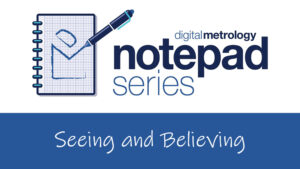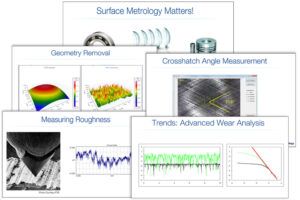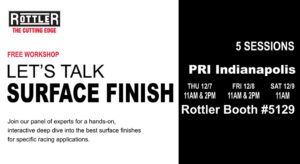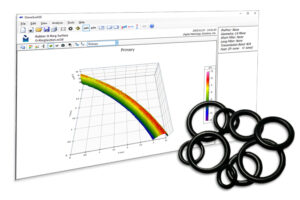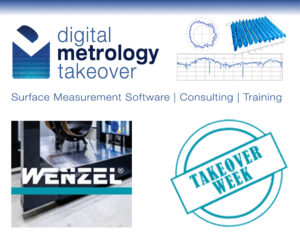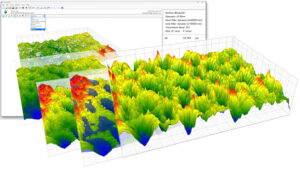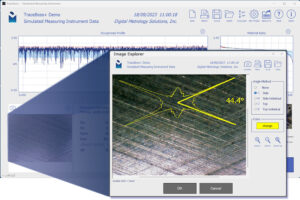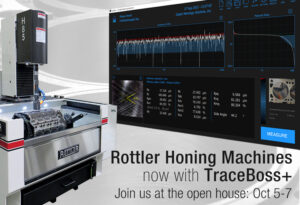New Notepad Series Video – Seeing and Believing
The last time you saw a zebra: was it black with white stripes, or white with black stripes? In this Notepad series we show how “stripes” of light and dark in surface texture can be an indicator of wear. The spacing of those stripes will depend on the surface geometry—and we’ll show you how do tell whether those stripes are due to changes in the longer wavelength waviness or shorter wavelength roughness.
Read MoreJoin us for a presentation at the NCSLI Tech Exchange
Join us at NCSLI's Technical Exchange for a session on the metrology of surface measurement (2D and 3D) and the many traps that people can fall into. We'll use case studies and actual surface data to explore the analysis essentials (geometries, filtering, and parameterization) to turn complex shapes into more manageable numbers.
Read MoreJoin us for panel discussions at PRI
Will you be attending the upcoming PRI (Performance Racing Industry) expo in Indianapolis?
At PRI, the panel of Mark Malburg (Digital Metrology), Ed Kiebler (Rottler Manufacturing) and Keith Jones (Total Seal Piston Rings) will dive into the topic of surface finishes for racing applications. These panel discussions will take place at the Rottler Manufacturing booth #5129. Dates and times for the panel discussions are shown below. Use the QR codes to register for the individual sessions!
Read More
Measuring an O-ring
Measuring the surface texture of this O-ring presents a challenge. With a small radius and cross-section, steep sides, and soft material, it’s almost impossible to measure with a stylus. An optical instrument can do the job...but that's just the first hurdle! In this Surface Notes blog post we show you how to use the Geometry Removal and Filtering tools in OmniSurf3D to measure this complex shape. You can try it for yourself as well—the dataset is available in our Surface Library!
Read MoreAre those valleys in my measurement data real?
"Can I trust my measurement?" That question drives us to produce meaningful measurement results. In this post we examine how dirt and debris can produce artificial "features" in surface texture data—errors that are sometimes the exact opposite of what you might expect to find. And those errors may have you chasing down changes in your process that aren't really there. We'll show you what to look for, and some steps you can take to tell whether features are real or not.
Read MoreDigital Metrology Takeover Week at Wenzel America
Wenzel America has invited Digital Metrology to take over their LinkedIn page for the week! For those of you who may not know, Wenzel (Wixom, Michigan) is the largest family-owned metrology company specializing in CMM high-speed optical scanning, gear inspection, and CT systems. Thanks to Wenzel, America for this opportunity to share some of our many resources with Wenzel's followers!
Read More60-Second Surface Analysis Video – Profile and Surface Displays
OmniSurf and OmniSurf3D guide you through the surface analysis process and show you what happens at each step. In this short video we introduce you to the profile/surface displays that walk you through each step and show you what's happening.
Read MoreHexagon Surface Texture
When Hexagon needed to analyze surface texture data from their optical roughness sensor, they turned to Digital Metrology and OmniSurf3D. Read more on our Collaborations page.
Read More60-Second Surface Analysis Video – TraceBoss+ Image Explorer
TraceBoss+ lets you analyze your surfaces by the numbers, and it also helps you SEE what’s happening with your process. This short video shows how the Image Explorer feature lets you import an image of a surface, calculate crosshatch angle, explore the surface quality, and save the image and numerical results in a single file.
Read MoreSee TraceBoss+ in Action at the Rottler Open House
Join Rottler Manufacturing for an Open House on October 5–7 to celebrate the company’s 100 year anniversary! The event will include live machine demonstrations, hands-on experience with factory technicians, technical seminars and presentations, and live music entertainment on Friday night. Digital Metrology’s Mark Malburg will join Scott Rowe (Rottler) and Keith Jones (Total Seal Piston Rings) for the session, The latest in cylinder wall finishes and piston rings and how to apply to your business. Thursday Oct 5th 9-11am. And check out Rottler’s demo honing machines, now running Digital Metrology's TraceBoss+ software! Event details, the full agenda, and hotel and travel information are available here.
Read More
